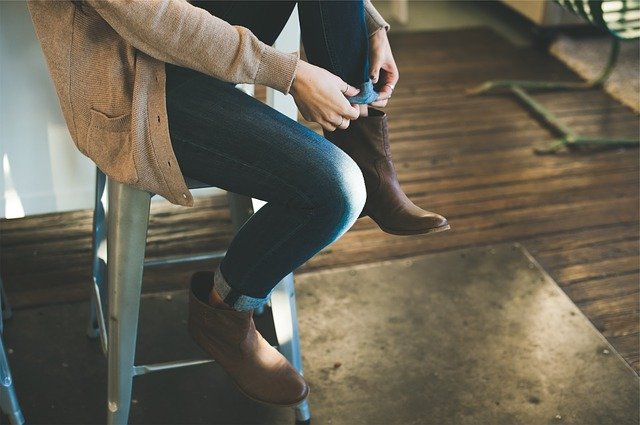Boots are a popular choice of footwear for jeans. When wearing jeans, many people prefer boots over traditional shoes. They are durable, comfortable and offer a high level of support. If you’re going to wear boots with jeans, though, there are a few things you need to consider.
#1) Length of Jeans
You should consider the length of the jeans. They need to be long enough so that you can fit them over or under the top of your boots. Jeans, of course, are available in different lengths. Some of them are longer than others. If your jeans are too short, they may not extend all the way to your boots. You can still wear short jeans such as this, but they’ll probably look awkward and unflattering. To avoid this headache, choose a pair of jeans in an appropriate length for your body.
For the perfect length, you can order a pair of custom-sized jeans. Custom-sized jeans are those that are customized according to your own body measurements. They aren’t sold in fixed measurements. When you order a pair of custom-sized jeans, you can specify the exact measurements of your waist and legs. As a result, they’ll fit perfectly while offering a higher level of comfort and style in the process.
#2) Washed or Raw Denim Jeans
Jeans are available in both washed and raw denim. Assuming you intend to wear them with boots, you may want to choose the former type. What’s the difference between washed and raw denim exactly? Washed denim lives up to its namesake by being washed during production. Manufacturers literally wash it before using it in the construction of a new pair of jeans. In comparison, raw denim is not washed during production.
Washed denim jeans are a better choice for boots than raw denim jeans. When made of washed denim, jeans won’t bleed their colors. The bottom of your jeans will typically touch the top of your boots. Assuming they are made of washed denim, you won’t have to worry about them staining your boots. Washed denim jeans don’t bleed, so they won’t stain your boots (or other footwear for that matter).
#3) Cut of Jeans
Something else to consider is the cut of the jeans. Cut refers to the way in which the jeans are designed to fit when worn. The cut isn’t the same as the size. The size simply refers to the measurements of the jeans, whereas the cut refers to the way in which they fit when worn. Straight leg, for instance, is a cut that involves the pant legs running straight through the legs.
Although there are many different cuts in which jeans are made, boot cut is the most popular choice for boots. Boot-cut jeans don’t run straight through the legs. Rather, they feature a flared bottom. At the bottom of the pant legs, the denim fabric flares out. With boot-cut jeans, you can slide these flared bottoms over the top of your boots. That’s why they are known as “boot-cut jeans.”
#4) Color Coordination
Don’t forget to color coordinate your jeans with your boots. In other words, your jeans should feature a color that matches the color of your boots. They can be the same color as your jeans. If you’re wearing black boots, you can choose a pair of black jeans. With that said, you can wear jeans in other colors as long as they coordinate.
Blue, of course, is a popular color for jeans. The color blue has even become synonymous with jeans. Ever since they were first invented over a century ago, jeans have been of blue-colored denim. Regardless of what type of boots you wear, they’ll probably color-coordinate with blue jeans.

#5) Stretch
You may want to choose a pair of stretch jeans to wear with boots. Stretch jeans feature the same visual design as regular jeans. The only difference is that they are made of a special type of denim known as stretch denim. Stretch denim contains an elastic material, such as lycra or polyester, that makes it more elastic.
Stretch jeans are an excellent choice for boots. Even if they aren’t boot cut, they can typically fit over the top of your boots. This is because stretch jeans are elastic. With their use of lycra or polyester, stretch jeans have elastic properties that aren’t offered in regular jeans. You can stretch the bottom of the pant legs over the top of your boots.
Stretch jeans are available in the same colors and the same cuts as regular jeans. They simply contain elastic material mixed into their construction. If you’re wearing boots, you may want to choose a pair of stretch jeans.
#6) Fading
Something else to consider when wearing jeans with boots is fading. Some jeans are designed with intentional marks or patterns of fading. They offer a more worn-in appearance than their counterparts.
The marks or patterns of fading on jeans such as this are known as whiskers. They resemble the whiskers of a cat or feline. On the knees and thighs of the pant legs, you’ll see streaks in which the color of the denim is slightly lighter than that of the rest of the jeans. Whiskers add a unique visual element that gives the jeans a more aged and worn-in appearance.
#7) Weight
Finally, consider the weight of the jeans. All jeans are made of denim. The use of denim is what distinguishes them other types of pants and trousers. With that said, some jeans are made with more denim than others, resulting in a heavier weight.
Heavyweight jeans are typically stronger and more durable than their lightweight counterparts, making them ideal for boots. Many people wear boots when hiking or working outdoors. With heavyweight denim, your jeans will withstand physical activities such as this without degrading or otherwise showing signs of wear and tear.











